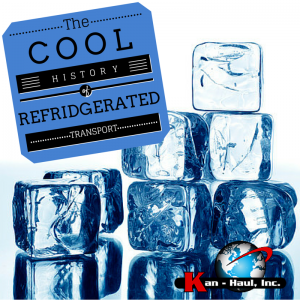June 12, 2015
The Cool History of Refrigerated Transportation
The concept o
In the Olden Cold Transport Times…
Long before electricity was even a concept in anyone’s mind, populations took primitive steps toward keeping food fresh. This usually came about by collecting snows to place inside caves, so that the food could be stored within the mounds collected.
Throughout the 17th Century, Europeans found a way to keep drinks cold by rotating bottles in water that had saltpeter within it. While this remained popular for decades, many more advancements needed to be made.
Taking Baby Steps with Ice Transportation
The first true experiments with refrigerated transport services took place in the last few decades prior to the Civil War, but all of these remained simplistic in nature and destined to fail. That’s because they were handicapped by other factors, whereby they could only be used during cold weather months or required large amounts of ice that would inevitably melt when the great distances needed to be traveled.
Something needed to be done to address what had effectively become a 50-mile curtain for any grower. That meant that anything outside a 50-mile radius from the site of where the perishable item was grown would be spoiled by the time a destination was reached.
Advancements in Refrigerated Transportation Are Made
Beginning in the late 1870’s, breakthroughs in refrigerated transport services began to occur. The first, created by Andrew Chase, emphasized both insulation and ventilation in rail cars, which sparked others to advance the concept even further.
The growing accessibility of ice was the result of a veritable explosion of commercial ice companies springing up. Over a 35-year span beginning in 1880, the amount of ice consumed tripled, and during this time other issues cropped up. These involved health-related factors that saw companies using polluted or otherwise unclean water to create ice.
The large number of commercial ice companies was the continuing result of companies not having the ability to go beyond a certain point to transport their foods. That was a direct result of the hit-and-miss approach with respect to improving refrigerated transport services.
Cold Transportation Innovations
The development of the automobile, followed subsequently by trucks, soon offered a new mode of travel. However, in the latter case, it required the development of refrigerated trucking that would allow for food to be transported more quickly and less expensively than via the rail system.
Even with all these advancements, companies still lost plenty of money because of an inability to keep items from spoiling. Many trucks were reduced to supplement their use of ice with fans that would continuously blow cool air or dry ice, but such thinking was merely a stopgap concept.
Taking a Great Leap Forward
By the late 1930’s, Fred Jones had received a patent for a portable air cooler, which was then placed around trucks that dealt with perishable food. Prior to this, the idea of grocery stores selling frozen foods was virtually non-existent, but this dramatic shift in refrigerated trucking helped effectively create this new segment of the food industry.
What became known as the Thermo King would go on to also be used for travel via the rails and across bodies of water. With the onset of World War II, it eventually was configured for airplanes, which allowed such vital supplies as food to eat and plasma for wounded soldiers.
The Thermo Kings became innocently known as reefer units, which was simply a shortened version of refrigerated trucking. These soon became the standard for all trucking companies, and with advancements in such areas as the condenser, evaporator and compressor, the trucking industry was able to grow its business accordingly.
With the start of the interstate highway system in 1956, trucking became even more important to the United States economy, since reaching far-flung places became much easier, with virtually no chance of spoilage of the cargo inside. The technology for refrigerated transportation only continues to improve, making the future possibilities virtually endless.
Kan-Haul continues to stay on the cutting-edge of cold transportation technology. For more information on what we can do for your logistics, contact Kan-Haul today!



